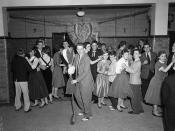Dance is a dangerous and rigorous profession. In some cases it can cause bruises, broken bones, and pulled muscles. In the worst cases it can lead to bulimia, anorexia, constant fatigue, low self esteem, and depression.
The History of Dance
The Italian princess Catherine de Medici married the French Henri II and introduced ballet de cour, or "court ballet" to the Court of France in the sixteenth century. In the 1600's, King Louis XIV especially loved dancing and starring in court productions. When he grew too old and fat to perform he continued to be one of ballet's greatest patrons. He founded the Académie Royale de Danse, which would later become the Paris Opera Ballet.
However, around 1730 danse haute superseded danse basse. Dancers took to the air. Rather than just move elegantly from lovely pose to lovely pose, they began to jump, hop, and leap. And women began to rebel against their restrictive costumes.
Marie Sallé literally let her hair down and donned looser clothes for her ballet d'action. Her rival, Marie Ann Cupis de Camargo, took the heels from her shoes and shortened her skirts to better perform the flashy new steps that had heretofore been done exclusively by men. (Entrechat quatre and cabriole)
Marie Taglioni often gets the credit and the blame for being the first to dance on Pointe. But no one really knows for sure. It is established that in 1832 Marie Taglioni danced in the full length La Sylphide on Pointe. Before we consider what Taglioni did and how she did it, let's look at why she rose on Pointe at all. The 1830's were the heart of the Romantic Age. The artists and poets of this era-- Keats, Byron, Shelly and Chopin-- were often concerned with beauty, passion, nature, the supernatural, and the...


